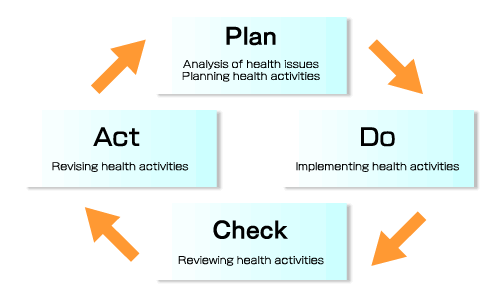Data Health Plans
The purpose of a Data Health Plan is to enable efficient and effective health activities based on the plan-do-check-act (PDCA) cycle and the analysis of various data, including medical cost data and information from health examinations. The Japanese government has asked all health insurance societies to implement their own Data Health Plans from the 2015 fiscal year.
- Tips
-
- A Data Health Plan is a plan for implementing health activities effectively and efficiently, based on an analysis of various data, including medical cost details (rezepts) and information from health examinations.
- This scientific approach is intended to make the activities more effective.
- A Data Health Plan will be formulated in conjunction with plans for specific health checkups and other activities.
- The six-year period from fiscal 2024 through fiscal 2029 marks the third period of the Data Health Plan.
Objectives of the Data Health Plan
Approved by the Japanese government in a June 2013 Cabinet decision, the Japan Revitalization Strategy identifies “extending the nation’s healthy life expectancy” as a key policy objective. Healthy life expectancy refers to the time for which a person can live free of health-related restrictions on day to day activities. An important goal of extending healthy life expectancy is to minimize the difference between average life expectancy and healthy life expectancy–i.e., the duration for which an individual is afflicted with health problems that restrict day to day activities. A Data Health Plan is intended to help achieve this goal.
Distinguishing features of Data Health Plans
Under a Data Health Plan, health activities will be managed in accordance with the PDCA (plan-do-check-act) cycle. This includes analyzing data, including data gleaned from rezepts and health examinations; ascertaining Society medical care costs; stratifying health risks; and identifying persons for whom health activities would be highly effective. Based on a data-driven scientific approach rather than undertaken haphazardly, activities based on this approach should prove more effective. This is the goal of the Data Health Plans.

Relationship to specified health diagnoses
Cycle to data-driven health activities by standardizing electronic data on health exams. Additionally, since plans for specified health diagnoses and other activities address specific methods for implementing both specified health diagnoses and specified health guidance, two key health activities, it is desirable for the Data Health Plan to be formulated in a manner linked to these plans, thereby making health activities more effective and efficient.
- Reference link
Planning period and announcing and publicizing the plan
The period covered by the third-term Data Health Plan is the six-year period from fiscal 2024 through fiscal 2029. Of this period, the first half is defined to be from fiscal 2024 through fiscal 2026 and the second half from fiscal 2027 through fiscal 2029. Plans for the second half will be revised as needed based on interim evaluations carried out at the end of the first half.
In addition, to ensure that members, employers, and other related parties understand the nature and objectives of the health activities and to make them more effective, the Data Health Plan will be announced via the Society website and bulletin. Additionally, other plans and efforts will seek to promote awareness among the affected parties.
- Reference link